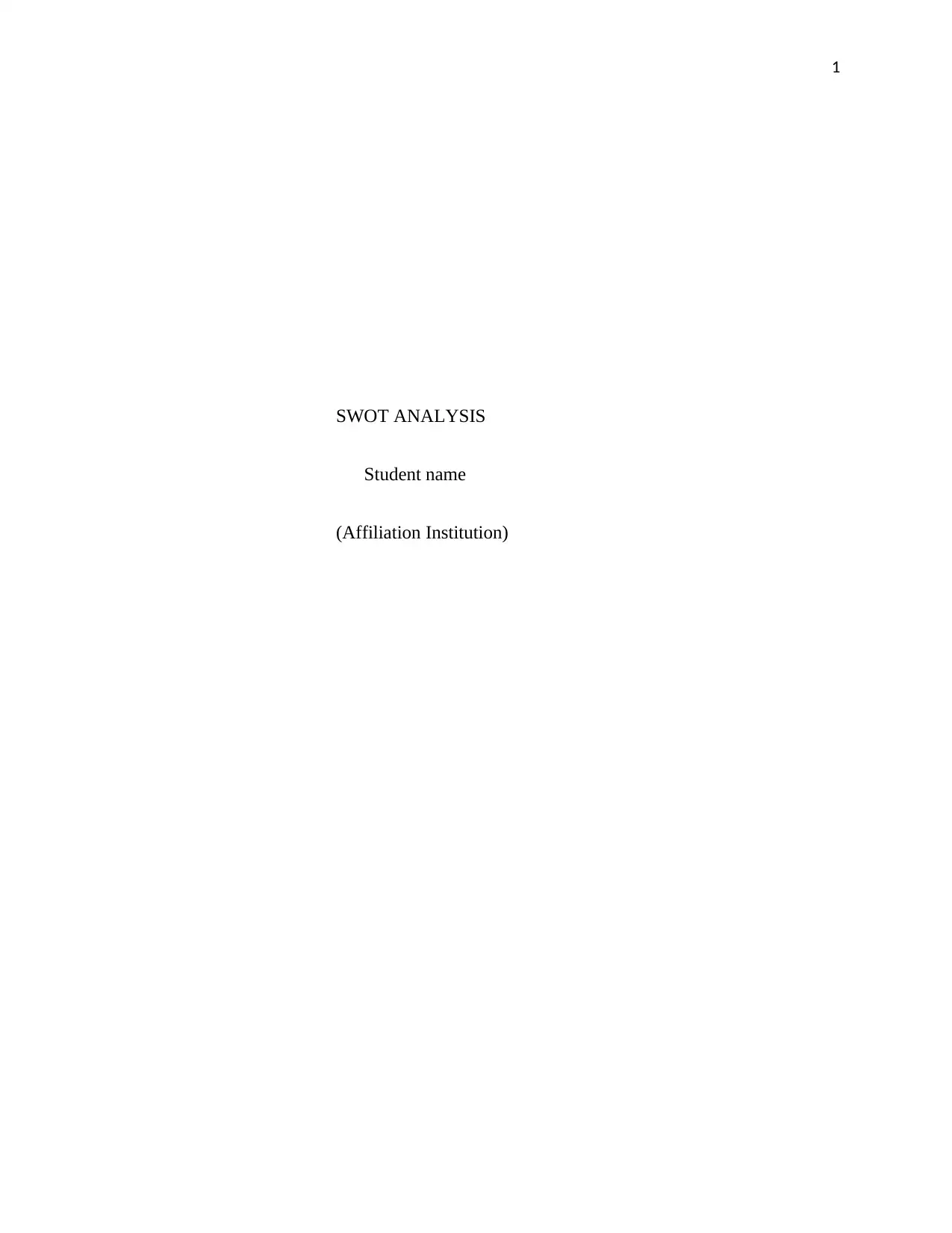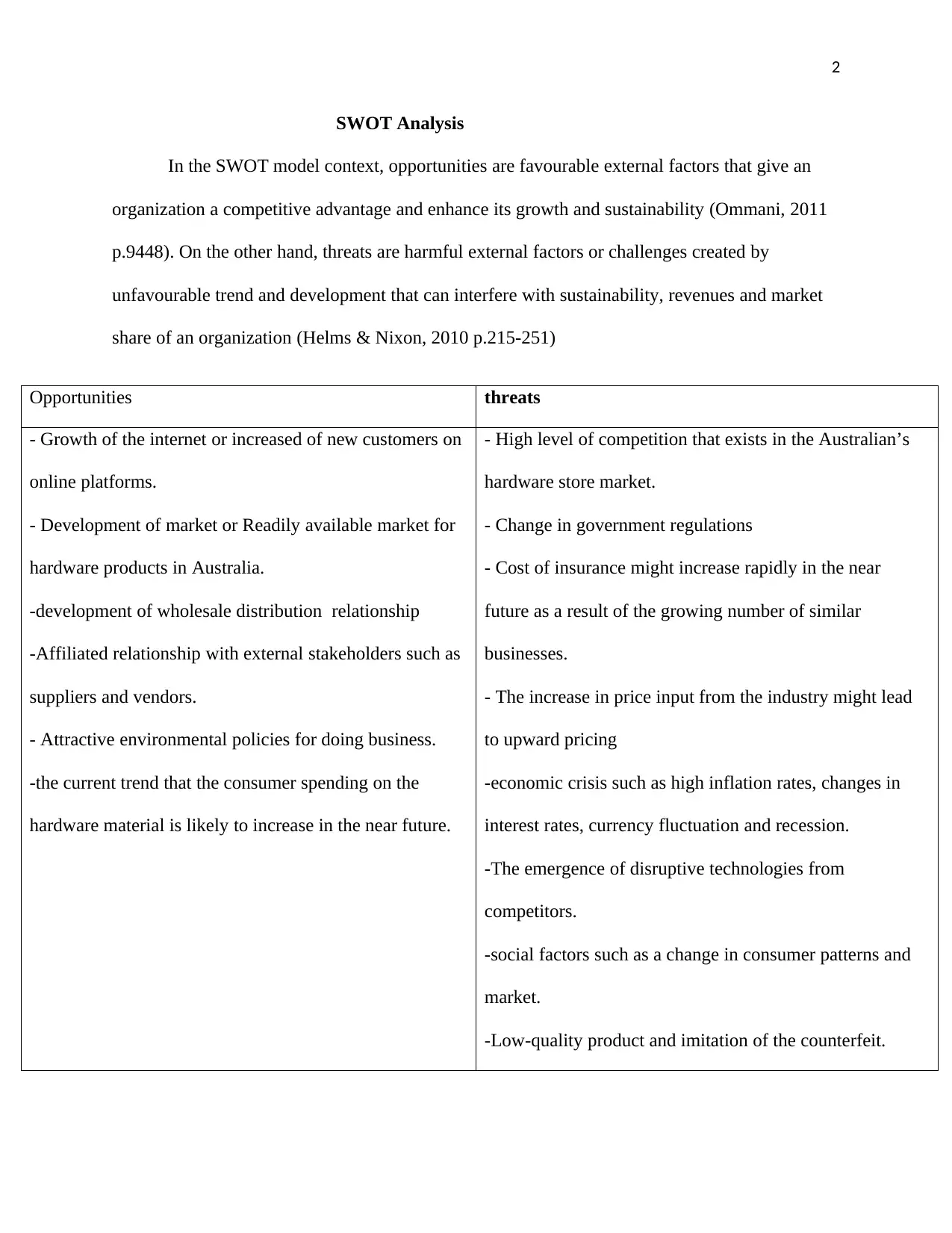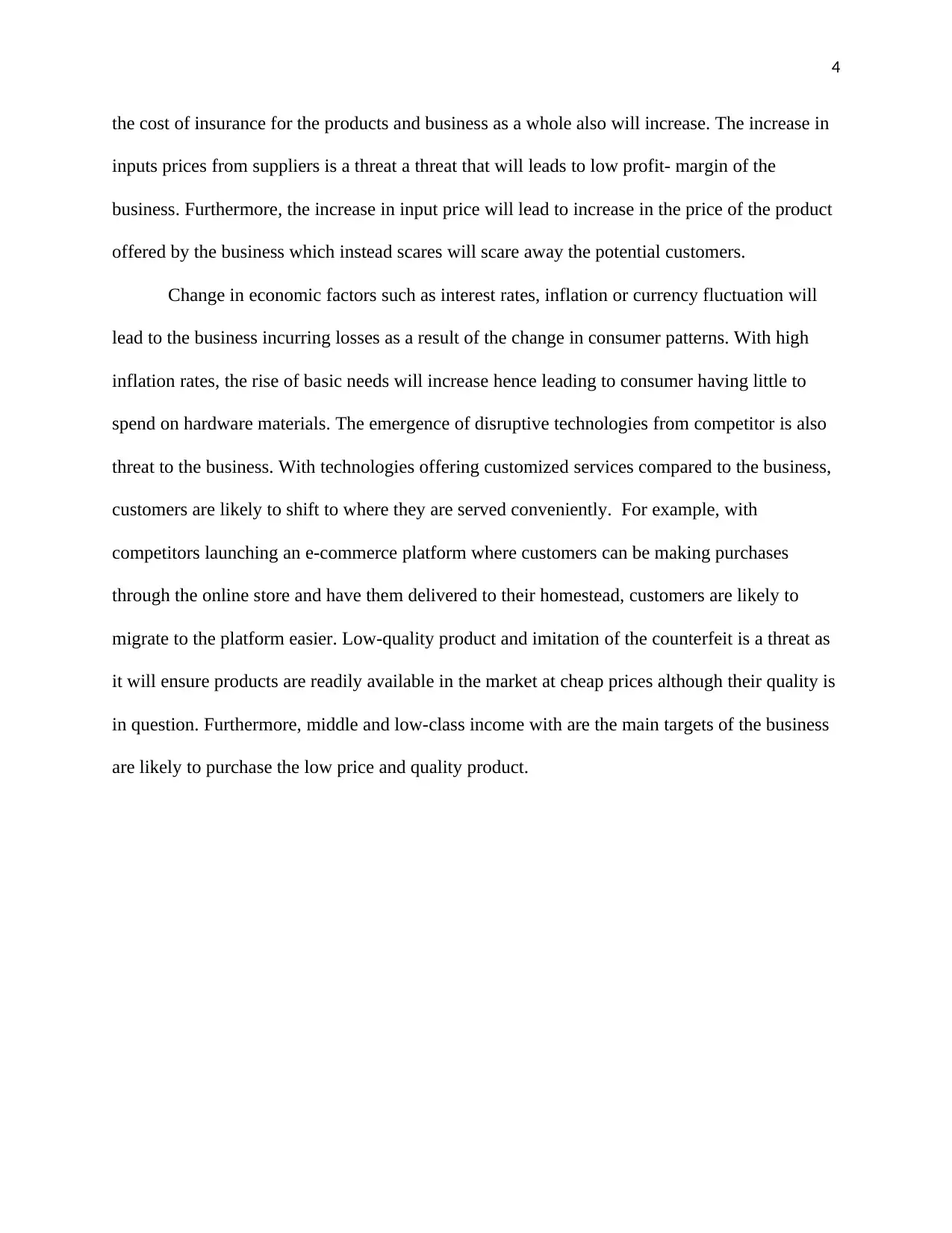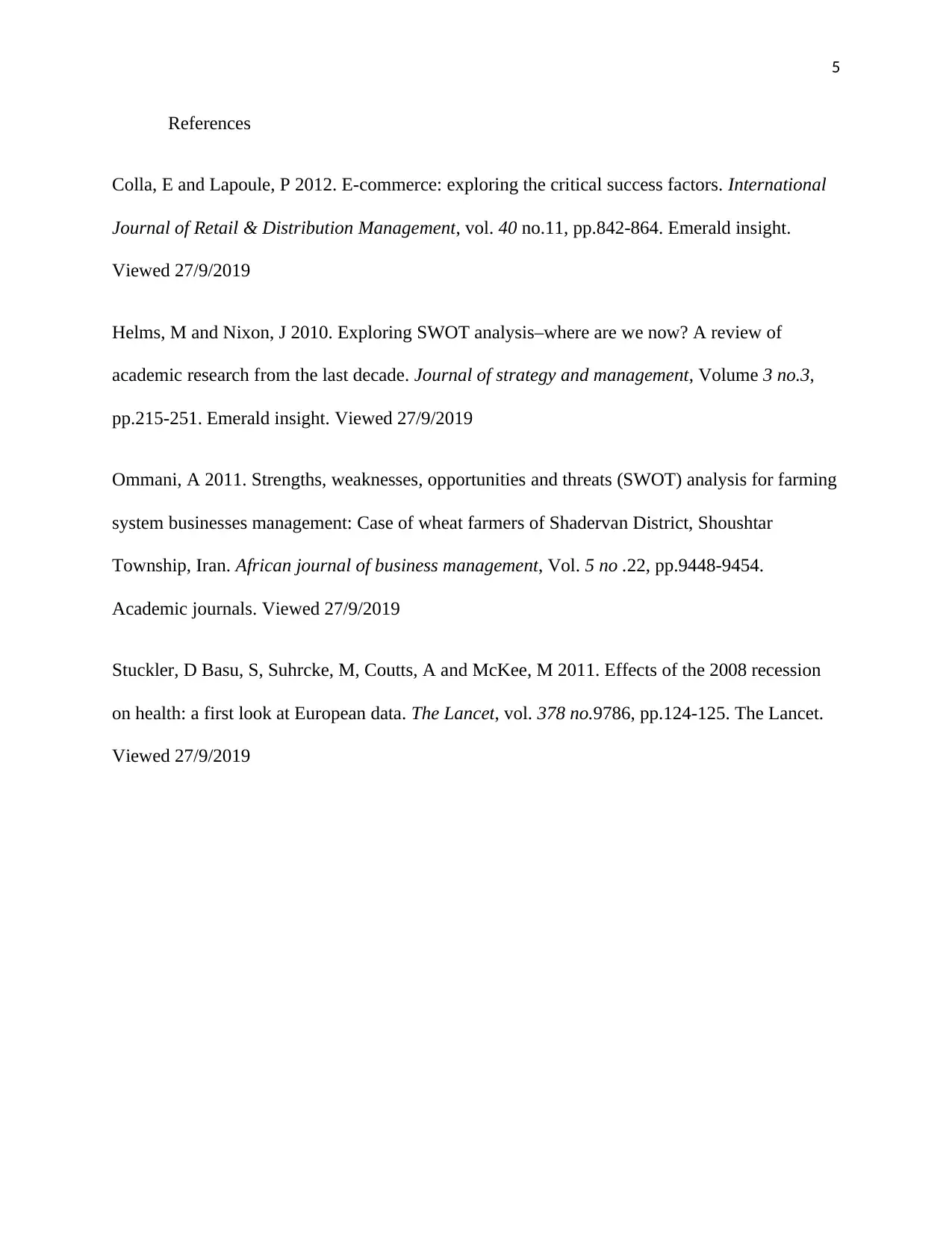Semester 2, 2019: SWOT Analysis Report for Hardware Business
VerifiedAdded on 2022/10/08
|5
|1012
|12
Report
AI Summary
This report offers a SWOT analysis of a hardware business, evaluating its internal strengths and weaknesses alongside external opportunities and threats. The analysis identifies opportunities such as internet growth, market development, and favorable environmental policies, which the business can leverage for expansion and increased income. Threats like intense competition, changing government regulations, increasing input prices, economic fluctuations, and the emergence of disruptive technologies are also discussed. The report also considers the impact of counterfeit products and changing consumer patterns. The analysis provides a comprehensive view of the business's strategic position, considering factors such as online platforms, market expansion, government regulations, and economic conditions, to aid in strategic planning and decision-making.

1
SWOT ANALYSIS
Student name
(Affiliation Institution)
SWOT ANALYSIS
Student name
(Affiliation Institution)
Paraphrase This Document
Need a fresh take? Get an instant paraphrase of this document with our AI Paraphraser

2
SWOT Analysis
In the SWOT model context, opportunities are favourable external factors that give an
organization a competitive advantage and enhance its growth and sustainability (Ommani, 2011
p.9448). On the other hand, threats are harmful external factors or challenges created by
unfavourable trend and development that can interfere with sustainability, revenues and market
share of an organization (Helms & Nixon, 2010 p.215-251)
Opportunities threats
- Growth of the internet or increased of new customers on
online platforms.
- Development of market or Readily available market for
hardware products in Australia.
-development of wholesale distribution relationship
-Affiliated relationship with external stakeholders such as
suppliers and vendors.
- Attractive environmental policies for doing business.
-the current trend that the consumer spending on the
hardware material is likely to increase in the near future.
- High level of competition that exists in the Australian’s
hardware store market.
- Change in government regulations
- Cost of insurance might increase rapidly in the near
future as a result of the growing number of similar
businesses.
- The increase in price input from the industry might lead
to upward pricing
-economic crisis such as high inflation rates, changes in
interest rates, currency fluctuation and recession.
-The emergence of disruptive technologies from
competitors.
-social factors such as a change in consumer patterns and
market.
-Low-quality product and imitation of the counterfeit.
SWOT Analysis
In the SWOT model context, opportunities are favourable external factors that give an
organization a competitive advantage and enhance its growth and sustainability (Ommani, 2011
p.9448). On the other hand, threats are harmful external factors or challenges created by
unfavourable trend and development that can interfere with sustainability, revenues and market
share of an organization (Helms & Nixon, 2010 p.215-251)
Opportunities threats
- Growth of the internet or increased of new customers on
online platforms.
- Development of market or Readily available market for
hardware products in Australia.
-development of wholesale distribution relationship
-Affiliated relationship with external stakeholders such as
suppliers and vendors.
- Attractive environmental policies for doing business.
-the current trend that the consumer spending on the
hardware material is likely to increase in the near future.
- High level of competition that exists in the Australian’s
hardware store market.
- Change in government regulations
- Cost of insurance might increase rapidly in the near
future as a result of the growing number of similar
businesses.
- The increase in price input from the industry might lead
to upward pricing
-economic crisis such as high inflation rates, changes in
interest rates, currency fluctuation and recession.
-The emergence of disruptive technologies from
competitors.
-social factors such as a change in consumer patterns and
market.
-Low-quality product and imitation of the counterfeit.

3
Why consider threats and opportunities factors in the SWOT analysis
Opportunities
Internet growth is an opportunity that the business should consider in order to generating
more income. A research conducted by Colla &Lapoule, 2012 p.842) shows that the number of
new customers is increasing rapidly through social media platforms like Facebook and Twitter.
Therefore, the company still can utilize these online platforms to market its products to the
outside world. The development of the market or readily available market creates an opportunity
for expansion of the business to other areas. Furthermore, the government free trade can enable
the business to venture successfully in diverse markets. Affiliated relationship with supplier and
vendors means there are customers either wholesalers or retailers who are always in demand of
hardware’s product. Therefore, through product differentiation, the company could explore this
opportunity significantly .Increased in customer spending due to the end of slow economic
growth and recession period that stroke the world in 2008 (Stuckler et al., 2011 p.124-125.) also
creates an opportunity for the business to increase sales in diverse regions where there is a low
level of competition.
Threats
Competition is the greatest threat faced by the company. With the increasing number of
competitors like home Timber & hardware, burnings, Mitre 10 and market being easier for
penetrating similar business, the company is likely to encounter reduced profits which may lead
to termination of the business. Changing in government regulation such as review of government
taxation or declaring some products offered by the company illegal threatens the business. With
the current trend that the government is planning to increase taxation to generate more revenue;
the business is likely to struggle in the flooded market. Furthermore, with increase in taxation,
Why consider threats and opportunities factors in the SWOT analysis
Opportunities
Internet growth is an opportunity that the business should consider in order to generating
more income. A research conducted by Colla &Lapoule, 2012 p.842) shows that the number of
new customers is increasing rapidly through social media platforms like Facebook and Twitter.
Therefore, the company still can utilize these online platforms to market its products to the
outside world. The development of the market or readily available market creates an opportunity
for expansion of the business to other areas. Furthermore, the government free trade can enable
the business to venture successfully in diverse markets. Affiliated relationship with supplier and
vendors means there are customers either wholesalers or retailers who are always in demand of
hardware’s product. Therefore, through product differentiation, the company could explore this
opportunity significantly .Increased in customer spending due to the end of slow economic
growth and recession period that stroke the world in 2008 (Stuckler et al., 2011 p.124-125.) also
creates an opportunity for the business to increase sales in diverse regions where there is a low
level of competition.
Threats
Competition is the greatest threat faced by the company. With the increasing number of
competitors like home Timber & hardware, burnings, Mitre 10 and market being easier for
penetrating similar business, the company is likely to encounter reduced profits which may lead
to termination of the business. Changing in government regulation such as review of government
taxation or declaring some products offered by the company illegal threatens the business. With
the current trend that the government is planning to increase taxation to generate more revenue;
the business is likely to struggle in the flooded market. Furthermore, with increase in taxation,
⊘ This is a preview!⊘
Do you want full access?
Subscribe today to unlock all pages.

Trusted by 1+ million students worldwide

4
the cost of insurance for the products and business as a whole also will increase. The increase in
inputs prices from suppliers is a threat a threat that will leads to low profit- margin of the
business. Furthermore, the increase in input price will lead to increase in the price of the product
offered by the business which instead scares will scare away the potential customers.
Change in economic factors such as interest rates, inflation or currency fluctuation will
lead to the business incurring losses as a result of the change in consumer patterns. With high
inflation rates, the rise of basic needs will increase hence leading to consumer having little to
spend on hardware materials. The emergence of disruptive technologies from competitor is also
threat to the business. With technologies offering customized services compared to the business,
customers are likely to shift to where they are served conveniently. For example, with
competitors launching an e-commerce platform where customers can be making purchases
through the online store and have them delivered to their homestead, customers are likely to
migrate to the platform easier. Low-quality product and imitation of the counterfeit is a threat as
it will ensure products are readily available in the market at cheap prices although their quality is
in question. Furthermore, middle and low-class income with are the main targets of the business
are likely to purchase the low price and quality product.
the cost of insurance for the products and business as a whole also will increase. The increase in
inputs prices from suppliers is a threat a threat that will leads to low profit- margin of the
business. Furthermore, the increase in input price will lead to increase in the price of the product
offered by the business which instead scares will scare away the potential customers.
Change in economic factors such as interest rates, inflation or currency fluctuation will
lead to the business incurring losses as a result of the change in consumer patterns. With high
inflation rates, the rise of basic needs will increase hence leading to consumer having little to
spend on hardware materials. The emergence of disruptive technologies from competitor is also
threat to the business. With technologies offering customized services compared to the business,
customers are likely to shift to where they are served conveniently. For example, with
competitors launching an e-commerce platform where customers can be making purchases
through the online store and have them delivered to their homestead, customers are likely to
migrate to the platform easier. Low-quality product and imitation of the counterfeit is a threat as
it will ensure products are readily available in the market at cheap prices although their quality is
in question. Furthermore, middle and low-class income with are the main targets of the business
are likely to purchase the low price and quality product.
Paraphrase This Document
Need a fresh take? Get an instant paraphrase of this document with our AI Paraphraser

5
References
Colla, E and Lapoule, P 2012. E-commerce: exploring the critical success factors. International
Journal of Retail & Distribution Management, vol. 40 no.11, pp.842-864. Emerald insight.
Viewed 27/9/2019
Helms, M and Nixon, J 2010. Exploring SWOT analysis–where are we now? A review of
academic research from the last decade. Journal of strategy and management, Volume 3 no.3,
pp.215-251. Emerald insight. Viewed 27/9/2019
Ommani, A 2011. Strengths, weaknesses, opportunities and threats (SWOT) analysis for farming
system businesses management: Case of wheat farmers of Shadervan District, Shoushtar
Township, Iran. African journal of business management, Vol. 5 no .22, pp.9448-9454.
Academic journals. Viewed 27/9/2019
Stuckler, D Basu, S, Suhrcke, M, Coutts, A and McKee, M 2011. Effects of the 2008 recession
on health: a first look at European data. The Lancet, vol. 378 no.9786, pp.124-125. The Lancet.
Viewed 27/9/2019
References
Colla, E and Lapoule, P 2012. E-commerce: exploring the critical success factors. International
Journal of Retail & Distribution Management, vol. 40 no.11, pp.842-864. Emerald insight.
Viewed 27/9/2019
Helms, M and Nixon, J 2010. Exploring SWOT analysis–where are we now? A review of
academic research from the last decade. Journal of strategy and management, Volume 3 no.3,
pp.215-251. Emerald insight. Viewed 27/9/2019
Ommani, A 2011. Strengths, weaknesses, opportunities and threats (SWOT) analysis for farming
system businesses management: Case of wheat farmers of Shadervan District, Shoushtar
Township, Iran. African journal of business management, Vol. 5 no .22, pp.9448-9454.
Academic journals. Viewed 27/9/2019
Stuckler, D Basu, S, Suhrcke, M, Coutts, A and McKee, M 2011. Effects of the 2008 recession
on health: a first look at European data. The Lancet, vol. 378 no.9786, pp.124-125. The Lancet.
Viewed 27/9/2019
1 out of 5
Related Documents
Your All-in-One AI-Powered Toolkit for Academic Success.
+13062052269
info@desklib.com
Available 24*7 on WhatsApp / Email
![[object Object]](/_next/static/media/star-bottom.7253800d.svg)
Unlock your academic potential
Copyright © 2020–2025 A2Z Services. All Rights Reserved. Developed and managed by ZUCOL.




